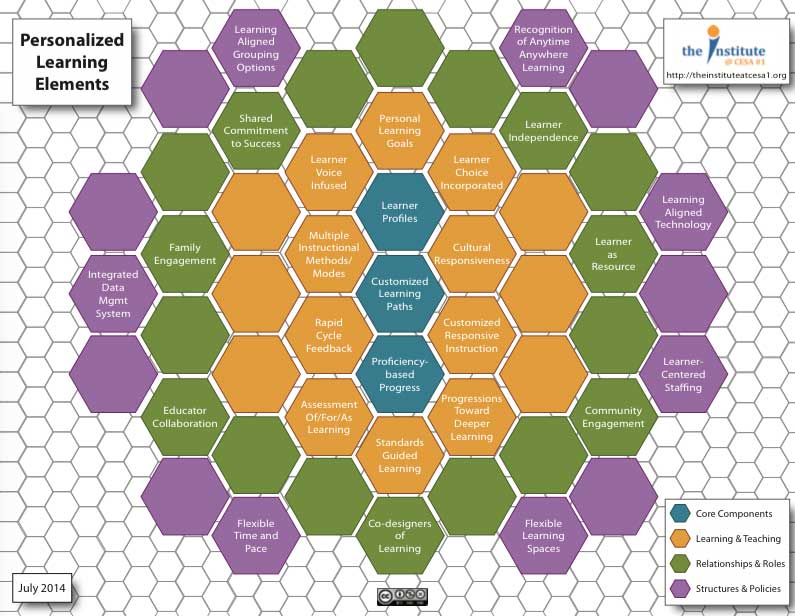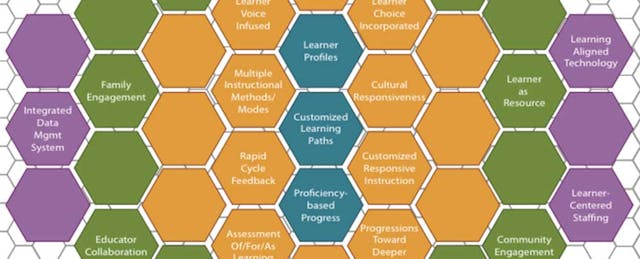As any educator will tell you, personalizing learning can be pretty messy when you get up close. Ideas and practices overlap—it’s nearly impossible to tackle one without touching another—and the work itself can be both overwhelming and exhilarating. But one thing remains constant: Underneath the layers of learning, the student is always at the center.
At Institute @ CESA #1, our mission is to establish personalized learning as the prevailing approach to educating youth. Part Wisconsin state agency and part non-profit, we developed a visual model to guide our work based on a simple concept found in nature--the honeycomb. But don’t let our neatly aligned, color-coded graphic organizer fool you, the honeycomb is an ideal representation of our work precisely because it allows for “messy.”

The arrangement of the honeycomb elements or “cells” is intentional. While the model is not linear, the work must begin at the center with the core components and generally expand outward toward the perimeter. It is crucial to begin with the learner—not logistics, trendy furniture, new schedules or even technology. The elements in the outer layers have a role to play, but their value comes later to help accelerate and scale the work or remove barriers to progress.
Start at the Core
Although the very nature of personalized learning allows for its implementation to take many forms, we believe three components form the core of a personalized learning system and keep the student at the center:
- Learner Profiles – Comprehensive, data-rich learner profiles convey how a student learns best and are used to plan a customized learning environment and instructional strategies.
- Customized Learning Paths – Students help create unique learning paths based on their individual strengths and interests. Content, pace and feedback are calibrated for each learner and needs are addressed as they occur rather than having to remediate later.
- Proficiency-based Progress – All students are expected to demonstrate mastery of rigorous, comprehensive standards. Progress is based on what students have learned, not how much time they have spent in school.
Then Add Layers
We strongly encourage teams to start with the core components outlined above and gradually add thoughtfully selected elements from our model. Moving outward from the center, the honeycomb framework defines the following layers:
- Learning and Teaching (orange) --The nexus of learning and teaching is where education transformation begins. The elements in this phase are focused on interactions at the classroom level and promote the concept of wrapping learning and teaching strategies around the unique strengths and needs of each student.
- Relationships and Roles (green) – A personalized approach will have a significant impact on the relationships and roles of both learners and educators. Increasingly, educators will work in interdependent teams andmay assume specialized roles that tap into their individual strengths and interests while at the same time meeting student needs. Learners have the opportunity to build the skills, knowledge and capacity to drive their own learning.
- Structures and Policies (purple) –Eventually, personalized learning practices will place stress on existing structures such as schedules, calendars and grading; only then should conversations about changing these structures begin. Policy changes should stabilize and support—not drive—personalized learning practices.
Remember the Tool Belt
Educators, leaders and school communities regularly use our honeycomb to support a number of tasks and processes as they build and sustain personalizing learning systems:
- The honeycomb is a great tool to help teams decide where to focus their initial efforts. While the core components are the foundation, the outer layers of cells offer a variety of options for teams to select and create their own unique approaches.
- As the work gains momentum, schools and teams use the honeycomb as a guide for determining where to build out and scale their work as they move forward. For example, they might chose to add opportunities for Customized Learning Paths or Learner Independence as well as expand their work to other classrooms.
- The core components and surrounding cells can guide professional learning activities for individual educators and teams; they are also useful in supporting collegial coaching and feedback.
- When educators and teamsfind themselves getting ahead of themselves or facing a roadblock, the framework can help them diagnose problem areas and create solutions. For example, if educators become preoccupied with questions such as how a learning space will be configured or what technology will be employed, the honeycomb directs them to first reach clarity on the core components outlined above.
- The honeycomb can be a helpful reminder when educators and teams fall victim to “shiny object” syndrome and are tempted to chase the newest fad. By analyzing potential efforts or tools using the honeycomb, they can quickly see what might contribute to the work and what might instead be a distraction and sidetrack their efforts.
- Finally, the honeycomb is used as a tool to communicate the rationale for and nature of educators’ efforts to create a personalized experience for every student.
Across the Institute’s network, the honeycomb is supporting the organic growth of personalized learning with exciting results. Over the past three years, students at one middle school have shown learning growth rates in reading and math that are more than twice the national average; students in other schools in the network are showing similar progress. A number of schools have seen more than a 50 percent decrease in disciplinary incidents. And in one urban high school, graduation rates have improved upwards of 10 percent in the past three years alone.
As mindsets and learning ecosystems continue to change, we expect to see the honeycomb have an increasingly meaningful impact on personalized learning everywhere. But even in starkly different educational environments--be they messy or neat, flexible or structured--the student will always remain at the center.


